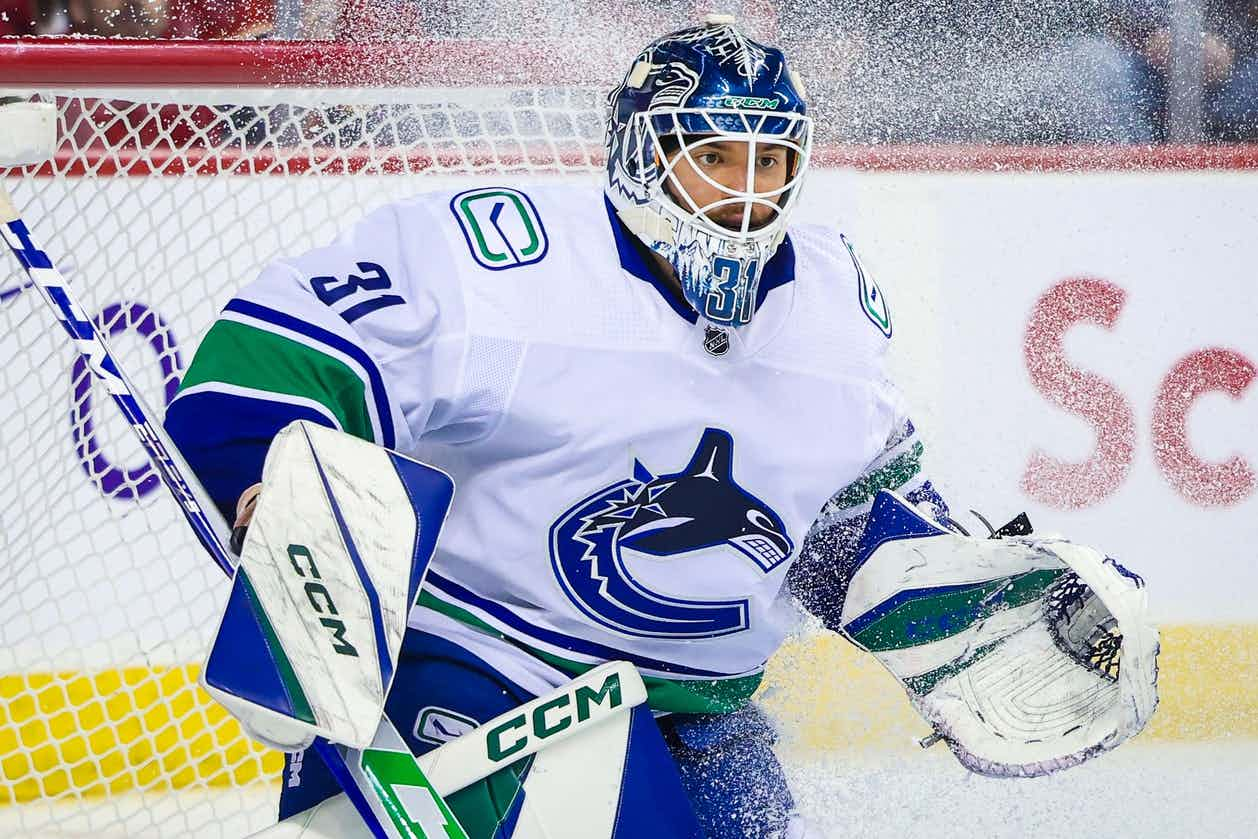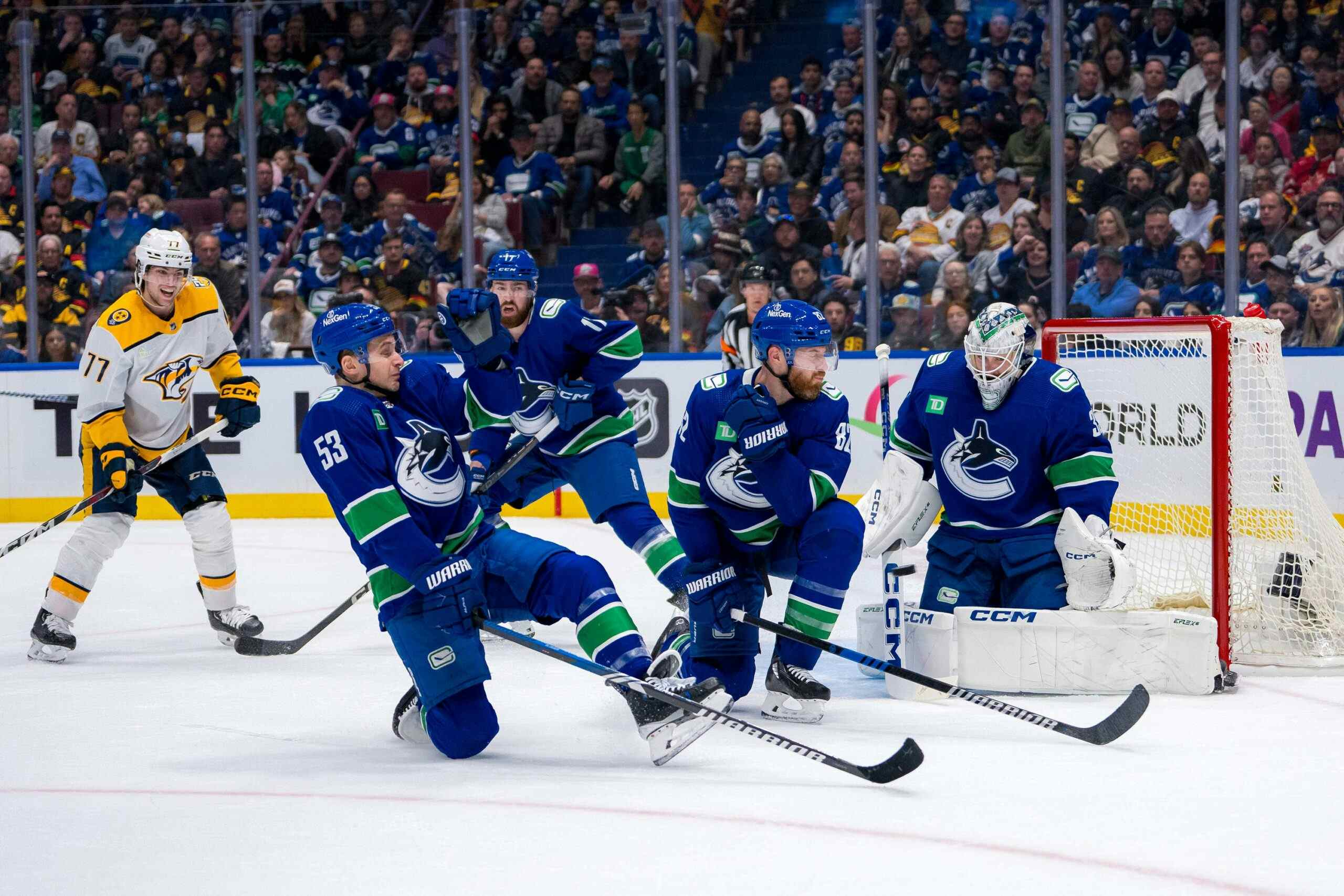Back from the Bottom
By Taylor Perry
7 years agoLet’s be completely honest, Canucks fans of a certain vintage have had it pretty good. There are some, born in the mid-1990s, who have no memory of sustained failure. In fact, this most recent stretch — which, neatly, coincides precisely with the arrival of the Sedin twins in 2000 — has been the longest period of excellence in franchise history (ending only recently, that is). The first 30 NHL Canuck seasons saw exactly one season of greater than 100 points and another 23 seasons with a losing record, and only three division championships. Being a Canuck fan was a matter of personal dedication.
Compare that to the past 16 seasons. There have been eight seasons of 100 or more points (helped, obviously, by the advent of the loser point), seven division titles, two President’s Trophies, and one trip to the Stanley Cup Final. Perhaps most notable of all, those 16 seasons have witnessed only one legitimate losing season (although it could — and should — be argued that 2014 was a losing season, too). Major post-season awards became something of a commonplace reality during this period, as were high expectations. No longer was simply “making the playoffs” the ultimate goal (again, until recently); the Canucks organization attempted everything in its power to contend for a Stanley Cup.
So maybe, for some Canuck fans, this current situation is mostly unfamiliar territory. But fear not! For those that remember the late 1990s — a.k.a the “Messier Years,” a.k.a “The Dark Ages” — the team was able to turn itself around and return to respectability. The transition took several years, plenty of organizational turmoil, and lots of losing. And much of the return can be attributed to a number of draft picks and trades during the dark years. For the purposes of our discussion today, we will focus on three of the latter and their implications for the team in an article tomorrow.
The Trevor Linden Trade
To NY Islanders: Trevor Linden
To Vancouver: Bryan McCabe, Todd Bertuzzi, 3rd Round pick (1998)
To this day, this trade stirs many bitter memories. Mark Messier brought in old buddy Mike Keenan as the Canucks new coach and Keenan assumed control of player personnel decisions. “Iron Mike” had taken the opportunity to humiliate the former Canuck captain and local hero during another dispiriting loss in St. Louis earlier that season and had benched him in a game against Montreal, as well. Linden didn’t feel at all shocked by the move when it finally happened. “I was given a lot of opportunity here and things weren’t happening for me,” he said, “So I think it became a situation that was going to happen and it wasn’t the biggest surprise.”
In many respects, though, this was a trade that almost needed to happen. From a performance perspective, Linden’s play had dropped off considerably since his career year in 1995-96. He had struggled with injuries during the 1996-97 season, playing in only 49 games and scoring only nine goals. The former NHL Ironman continued his decline during the 1998 season, managing only seven goals in 42 games despite being named to the Canadian men’s Olympic team.
This last fact is important. Despite being objectively past his peak by February 1998, Linden was still considered a valuable commodity in NHL circles. He was on his way to Nagano to represent Canada (where he would do this) and there was still an enormous opportunity to maximize the return on any transaction involving Linden.
Keenan was accurate with his comments following the trade. “I’m excited about the youngsters we’ve acquired,” he said. “They help solidify our situation now and in the future.” He likely did not realize how prescient those comments would become. McCabe – at the time the Islanders’ captain – was slated to become a key cog on a young Canucks defense that included Mattias Ohlund and Adrian Aucoin (and another player we’ll discuss below). Instead, he would be shipped to the Chicago Blackhawks a year later as part of the series of trades that landed the Canucks a pair of Swedish twins. That said, McCabe had a very successful career, scoring over 500 points playing mostly with the Toronto Maple Leafs. Bertuzzi, meanwhile, would become one of the most prominent power forwards in the league starting in 2002 and a member of the famous West Coast Express line. That third round pick, by the way, turned into an annoying pest from Finland, Jarkko Ruutu. All in all, despite the disappointment at the time, not a bad return on a depreciating asset.
The Pavel Bure Trade
To Florida: Pavel Bure, Bret Hedican, Brad Ference, 3rd Round pick (either 1999 or 2000)
To Vancouver: Ed Jovanovski, Dave Gagner, Kevin Weekes, Mike Brown, 1st Round pick (either 1999 or 2000)
Canucks fans and even players had been waiting for this trade since Pavel Bure announced his intention to hold out for a trade the previous summer. It just didn’t happen to be quite what they expected at the time. Bure, one of the most exciting and electrifying players to ever play the game — let alone wear a Canucks uniform — was one of only two players remaining from the 1994 Cup Final team. Bret Hedican was the other. This trade then, in many ways, was a firm break with the past.
Initial reaction to the trade was mixed, but that may have had more to do with high expectations. In the year 1999, this was simply par for the course. The coaching staff felt the acquisition of Gagner would give the team much-needed depth at centre. Instead, he gave them 33 games, two goals, and never played in the NHL again. Kevin Weekes, GM Brian Burke’s vaunted “goalie of the future,” was traded again within the calendar year and later provided his, um, insightful (?) commentary for Hockey Night in Canada following his playing days. Mike Brown fought a few scraps for the Canucks before spending most of the remainder of his career in the minors. And the less said about Nathan Smith — the player the Canucks selected in 2000 with the first round pick acquired from Florida — the better. Actually, why not? It’s a pretty funny story.
It was the young defenceman Jovanovski who was the true centrepiece of the deal for Vancouver. The former first overall pick, Calder finalist (1996), and Team Canada World Cup reserve player (also 1996), was struggling to live up the early expectations he had set for himself. Nonetheless, Keenan was still impressed by the young player. “Jovanovski had a great year his freshman season and all of a sudden there were expectations he was going to carry the franchise.,” he said, “That was a huge load.” As a Canuck, Jovanovski would develop into a top offensive defenseman and emotional leader for the franchise.
Bure would continue to score goals in a Panthers uniform, and Hedican would play almost another decade in the league – winning a Cup with Carolina in 2006. But Bure would succumb to his knee injuries and be out of hockey by 2003. The Canucks were able to extract some value for Bure, but not nearly as much as they probably could have (and likely threw in more than necessary for the return). Nevertheless, a future core player was acquired in the transaction. That was the least that could be expected when trading a player of Bure’s calibre.
The Alexander Mogilny Trade
To New Jersey: Alexander Mogilny
To Vancouver: Denis Pederson, Brendan Morrison
At the 2000 NHL trade deadline, seemingly everyone in Vancouver was speculating that the suddenly surging Canucks would be dealing a high-priced veteran out of town. Most, however, believed it would be aging centre Mark Messier getting dealt. Instead, it was the Canucks’ hottest scorer at the time, Alexander Mogilny. Mogilny wasn’t exactly having himself a banner season (only 38 points in 47 games at the time), but he had been one of the only consistent Canuck forwards at the time of the trade, scoring 6 goals in his previous 7 games.
“I’m not raising the white flag in any sense,” said GM Brian Burke at the time, but many in the media thought the trade signalled the beginning of the end for the Canucks playoff hopes. Burke was under pressure from ownership to trim the budget and trading one of Messier or Mogilny was probably inevitable. Fans were unimpressed, however. For a team that had not made the playoffs since 1996, trading Mogilny was initially viewed as a major setback. Morrison and Pederson, meanwhile, were no longer in the good graces of Devils’ GM Lou Lamoriello, so the acquisition of Mogilny did not appear to cost them much. And it worked out, too. The Devils would win the Stanley Cup that spring.
But the trade was not the loss for the Canucks that almost everyone predicted. Despite Mogilny having plenty of success over the next several years, Brendan Morrison would become an important piece of the Canucks new core. The doom-and-gloom predictions of dire consequences that immediately followed the trade soon dissipated. The Canucks continued their run towards the playoffs with Morrison and, to a lesser extent, Pederson, helping the charge. Although they fell just short, the Canucks would qualify for the playoffs each of the next four seasons and play a very entertaining brand of hockey in the process.
Naturally, these trades cannot be taken in isolation. But in many respects, these three trades in particular set the stage for a franchise reset that resulted in the longest sustained period of franchise success in Canuck history. What implications this history has for today’s team, and whether such an approach can be replicated, will be the subject of another post – coming tomorrow.
Recent articles from Taylor Perry





